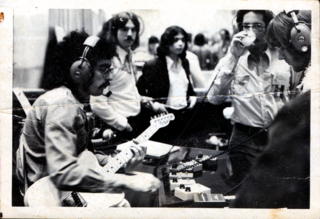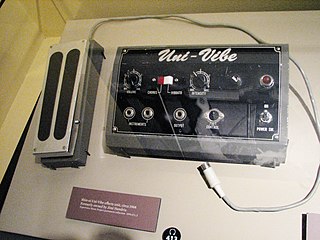

The MXR Phase 90 is a phaser effects pedal introduced in 1972 by MXR.


The MXR Phase 90 is a phaser effects pedal introduced in 1972 by MXR.
The Phase 90 was the first pedal sold by MXR and helped launch the company in 1974. [1] The original model had a simple orange enclosure with a script style MXR logo. In 1977 MXR changed its logo to a block style. There was a transitional period in which some Phase 90s with script logos had box logo circuits, and vice versa. Production ceased when MXR went bankrupt in 1984. [2]
When Jim Dunlop bought the MXR brand, production resumed. The Dunlop models have an LED to indicate the effect is engaged, and an optional AC power supply. There are several styles, including the standard block logo version, a reproduction of the script logo version, and an Eddie Van Halen signature model. [3] Van Halen first heard Robin Trower use the pedal in the mid-1970s, and used it on songs such as "Eruption", "Atomic Punk", "Ain't Talkin' 'bout Love", "Everybody Wants Some!!", and "Drop Dead Legs". [4] The 1974 Hand Wired Phase 90 is a recreation of an original 1974 pedal using new old stock (NOS) electronic components.
The Phase 90 has an orange enclosure with a single control knob:
The earliest "block" variants differ from the "script" variants in that they have a more pronounced sound (caused by the addition of a 24 kΩ feedback resistor) and the maximum speed is slightly higher (caused by the replacement of a 10 kΩ resistor in the effect's low-frequency oscillator with a 4.7 kΩ one); some later vintage units also have emphasis and de-emphasis circuits. [5] [ better source needed ]

An effects unit, effects processor, or effects pedal is an electronic device that alters the sound of a musical instrument or other audio source through audio signal processing.
Danelectro is a brand of musical instruments and accessories that was founded in Red Bank, New Jersey, in 1947. The company is known primarily for its string instruments that employed unique designs and manufacturing processes. The Danelectro company was sold to the Music Corporation of America (MCA) in 1966, moved to a much larger plant in Neptune City, New Jersey, and employed more than 500 people. Nevertheless, three years later Danelectro closed its plant.

Dunlop Manufacturing, Inc. is a manufacturer of musical accessories, especially effects units, based in Benicia, California, United States. Founded in 1965 by Jim Dunlop Sr., the company grew from a small home operation to a large manufacturer of music gear. Dunlop has acquired several well-known effects pedal brands, including Cry Baby, MXR and Way Huge.

Thomas Martin Dumont is an American musician and producer. Dumont is a member of third wave ska band No Doubt, and during the band's hiatus, he began Invincible Overlord as a side project and produced Matt Costa's Songs We Sing.
"Eruption" is a guitar solo performed by Eddie Van Halen and the second track from Van Halen's self-titled 1978 debut album. It is widely considered to be one of the greatest guitar solos of all time, having popularized tapping. It segues into a cover of the Kinks' "You Really Got Me", and the two songs are usually played together by radio stations and in concert. The song was later included as the B-side to the group's second single, "Runnin' with the Devil".
A phaser is an electronic sound processor used to filter a signal by creating a series of peaks and troughs in the frequency spectrum. The position of the peaks and troughs of the waveform being affected is typically modulated by an internal low-frequency oscillator so that they vary over time, creating a sweeping effect.

The Wurlitzer electronic piano is an electric piano manufactured and marketed by Wurlitzer from 1954 to 1983. Sound is generated by striking a metal reed with a hammer, which induces an electric current in a pickup. It is conceptually similar to the Rhodes piano, though the sound is different.

The Dunlop Cry Baby is a popular wah-wah pedal, manufactured by Dunlop Manufacturing, Inc. The name Cry Baby was from the original pedal from which it was copied, the Thomas Organ/Vox Cry Baby wah-wah, first manufactured in 1966. Thomas Organ/Vox failed to register the name as a trademark, leaving it open for Dunlop. More recently, Dunlop manufactured the Vox pedals under licence, although this is no longer the case.

The Pro Co "The RAT" is a distortion pedal produced by Pro Co Sound. The original RAT was developed in the basement of Pro Co's Kalamazoo, Michigan facility in 1978. Numerous variations of the original RAT pedal are still being produced today.

The Echoplex is a tape delay effect, first made in 1959. Designed by Mike Battle, the Echoplex set a standard for the effect in the 1960s—it is still regarded as "the standard by which everything else is measured." It was used by some of the most notable guitar players of the era; original Echoplexes are highly sought after.

MXR is a New York–based manufacturer of effects pedals from Rochester. The company was co-founded in 1972 by Keith Barr and Terry Sherwood and incorporated as MXR Innovations, Inc. in 1974. The MXR trademark is now owned by Jim Dunlop.

William Brent Hinds is an American musician best known as the lead guitarist of the Atlanta, Georgia metal band Mastodon, in which he shares guitar duties with Bill Kelliher and vocal duties with Troy Sanders and Brann Dailor.

The Uni-Vibe, also marketed as the Jax Vibra-Chorus, is a footpedal-operated phaser or phase shifter for creating chorus and vibrato simulations for electric organ or guitar. Designed by audio engineer Fumio Mieda, it was introduced in the 1960s by Japanese company Shin-ei originally branded as the Vibra-Chorus. The effect was modified to have easier access to its fuse, and a speed control foot pedal was added. It was later released in North America by Univox in 1968.
The MXR Dyna Comp is an effects unit, which is an electronic device that alters the sound of a musical instrument. This effects unit is produced by the MXR company intended for use with electric guitar. Made since the 1970s, the MXR Dyna Comp, which adds its own coloring to the tone, has become a frequently copied and widely used guitar effect, even a standard.

The Fender Noiseless series is a line of electric guitar pickups made by the Fender Musical Instruments Corporation designed to cancel 60 cycle (Hz) hum noise while retaining the characteristic sound of single coil pickups. Introduced in 1998, these pickups consist of a pair of single coils stacked one on top of the other, compacted so as to match the shape and width space as a traditional Fender single coil guitar pickup, while being only slightly taller. The upper coil is actually the sound source, while the lower coil is responsible for the mains hum attenuation. Alnico V magnetic bars span from one coil to the other, crossing a soft ferrous steel spacer plate that isolates them, without touching it. The spacer plate has mainly two functions: to isolate the lower coil from the vibrations of the string, making sure that the sound is picked up only from the upper one, and to increase the magnetic flux that passed through both coils, increasing the output of the pickup. This is to be contrasted with the original noise canceling pickup, the humbucker, which is a double-wide, horizontally adjacent pair of single coil pickups with opposing phase.

The Peavey EVH Wolfgang guitar series is a collaboration between guitarist Eddie Van Halen and Hartley Peavey's company, Peavey Electronics. The EVH stands for "Eddie Van Halen" while Wolfgang is the name of Eddie Van Halen's son.

Richard Ian Faulkner is an English musician best known as one of the lead guitarists for the heavy metal band Judas Priest since 2011, replacing original member K. K. Downing. Faulkner has also performed with Lauren Harris, Christopher Lee, Voodoo Six, Deeds, and Ace Mafia.
Keeley Electronics is an American manufacturer of effect units for electric guitars. The company, founded by Robert Keeley and operating from Oklahoma City, Oklahoma, started with the Keeley Compressor pedal along with modifications for effects by Boss and Ibanez.

The EVH Wolfgang is an electric guitar manufactured by Eddie Van Halen's company, EVH, which is owned by Fender Musical Instruments Corporation. The Wolfgang is named after Van Halen's son Wolfgang Van Halen, as well as classical composer Wolfgang Amadeus Mozart.
{{cite web}}: CS1 maint: unfit URL (link)